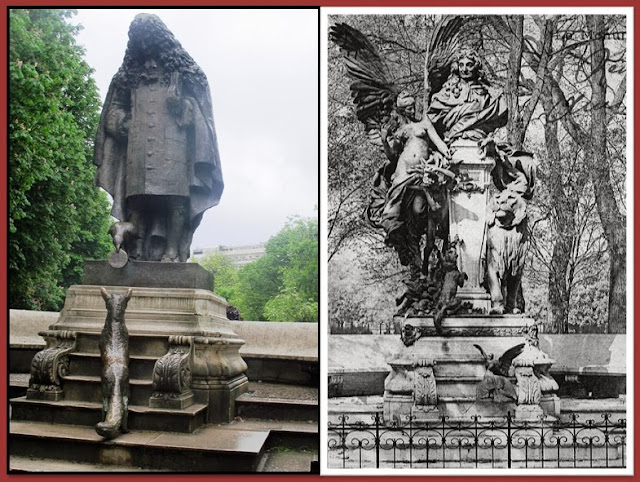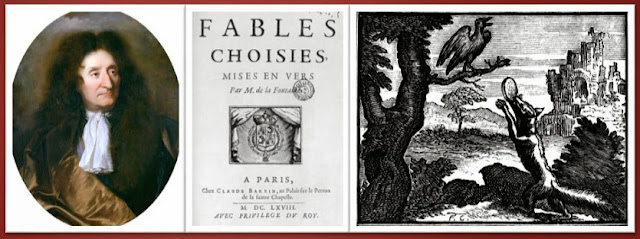The fabulist
Jean de la Fontaine (1621-95) has his statue in the Ranelagh Gardens (see
previous post). The present statue from 1984 replaces a statue from 1891 which
among many others disappeared during WWII - the metal was required by the occupants for other use. (The stand is the original one.)
The present
statue refers more particularly to the fable “The Fox and the Crow” and we can
see that the fox and the crow were represented already on the previous statue.
The fable which
of course serves as a warning against listening to flattery was published in 1668
in an illustrated version in the first of 12 volumes of fables. Jean de la Fontaine made no secret of the fact
that he often based his fables on existing ones. This fable is already
attributed to the Greek fabulist Aesop (620-564 BC) and exists also in other
cultures, e.g. in India.
Here you
can read La Fontaine’s fable in its French and a translated English version.
La Fontaine
is buried, close to his friend Molière, at the Père Lachaise cemetery (see previous
post). (Their remains were brought there in 1817 in order to attract interest for the cemetery, then newly opened and by people considered to be too
far from the city centre.)





















9 comments:
Bonjour cher Peter,
Je ne savais pas et je ne suis jamais passée par là pour admirer cette statue.
Une très belle oeuvre des héros de l'une des fable de Jean de La Fontaine.
J'ai tant appris de fables de lui.
Je me souviens encore petite avoir illustré de nombreuses de ses fables sur mon cahier de poésies.
Plus tard, j'ai offert à mes enfants de nombreux livres merveilleusement bien illustrés de La Fontaine.
Des fables qui symbolisent l'exemple.
Merci cher Peter pour ce joli billet.
I've always loved that fable and it makes me smile that it's on the streets of Paris.
They are both beautiful statues, Peter, though I prefer the old one. How sad that it was destroyed for the war effort.
Many thanks for sharing excellent informations. Your internet site is very awesome. I am amazed by the information that you have on this web site. It reveals how nicely you perceive this topic. Bookmarked as their favorite this web page, will come back for extra posts. You, my pal, ROCK! I found just the info I already searched all over the place and just could not come across. What a good web page.
Cardsharing Server
Ne serait-ce pas la fable la plus célèbre de La Fontaine. Dans le parc du Puy du Fou il y est fait référence également.
Un jour je l'ai entendu en argot, ça valait son pesant de cacahuètes.
This is a wonderful fable which is a favorite of George Washington's too. I saw it in Fredricsburg, Va. years ago and have not forgotten the message. Fancy that you should show it here now...so pleased that you did. Merry Christmas and Happy New Year.
Les fables de La Fontaine sont, certes, moralisatrices, mais on peut remarquer que les "méchants" - la cigale imprévoyante ou le renard flatteur et fourbe - par exemple, sont quand même plus sympathiques que la fourmi - avare et peu charitable - ou le corbeau - orgueilleux et sot. Peut-être parce que La Fontaine était lui même flatteur et imprévoyant.
Love the literary connections here...
¡Mi fabula favorita!
La estatua es preciosa...
Gracias Peter.
Maria
Post a Comment